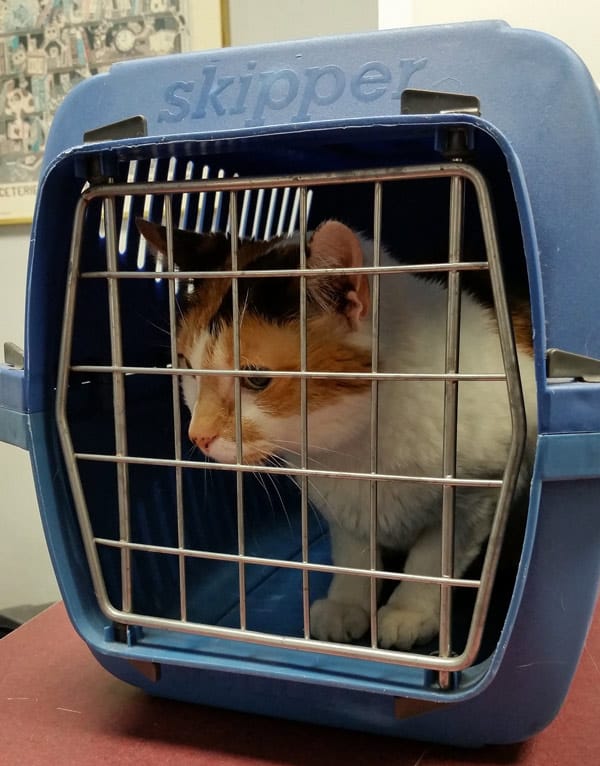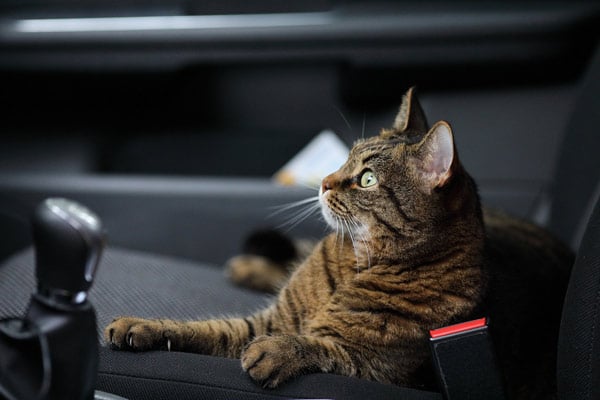Moving with a cat across the country can be quite challenging for a number of reasons.
Cats are very sensitive creatures who love their daily routine and they don’t particularly like it when they are taken way of their comfort zone. When taken to a new place, cats will usually go through a rough adaptation period that can take quite a while.
The trouble with moving with cats across the country is that their actual transportation to the new home can be more difficult than you anticipate. And to make things even more “fun”, the enhanced sensitivity of cats will let them know that a big change is coming around the corner so they are likely to start feeling anxious and stressed out at the sight of the first cardboard box.
Pay attention to these 7 tips for moving with a cat across the country so that the interstate relocation goes smoothly for both you and your pet animal.
Maintain your cat’s routine
One of the most important things you should do when you’re moving with a cat long distance is to make an effort to maintain their daily routine during the period leading up to the actual move.
Cats are creatures of habit and they depend on their daily routine to feel calm, safe, and happy. They love it when their food appears magically at roughly the same hours during the day and they need their environment to remain unchanged to feel secure in it.
A house move is known to bring plenty of changes for pets and some of them have a hard time adjusting to the altered reality for them. And yet, what you should do is keep their world relatively unchanged at least until moving day. How?
- Continue to feed your cat at the usual feeding hours. In most cases, there won’t be any real necessity to alter those times.
- Offer your animal companion roughly the same degree of attention as before, whenever possible.
Make an effort to keep your cat calm
When your cat senses that things are changing – too many boxes, too much noise and commotion, and practically – too much of almost everything else, there’s a high chance that your pet will get anxious, agitated, and stressed out.
So, you should try to keep your animal friend calm during the stressful pre-move period.
- Stay calm. Your cat will probably sense the subtle changes in your behavior, including the tone of your voice, and react correspondingly. If you get worried and stressed out, your pet will most likely become worried and stressed out too. So, one proven technique to keep your cat stress-free when moving is for you to remain calm and composed.
- Keep your pet far from strangers. Keep your cat in a room away from people he or she doesn’t know – for instance, when various people visit your home during the preparation period – representatives of the moving company you’re working with, friends to give you a hand with packing, nosy neighbors to check up on you, and so on.
Prepare the cat’s transportation carrier
One thing you should keep in mind when you plan to move with a cat across the country is that, unlike a dog, a cat must always be placed inside a suitable carrier when traveling in a car. This is for their own safety and the safety of all passengers.
If you have no other option but to ship your cat by air, then the pet carrier has to meet specific requirements. So, it’s best to contact the airline company (or visit their website) in order to learn what those transportation carrier requirements are.
But if you intend to transport your cat in your own vehicle, then you should either use the pet carrier you have in your home or visit the nearest pet shop to get one. Either way, don’t make the mistake of letting your pet animal loose inside the car – even if they seem calm enough, they may suddenly get scared of something and become largely unpredictable in their behavior.
Book an appointment with the vet
One of the most practical tips for moving with a cat is to call the family vet and book an appointment for your feline pet for a day shortly before the move-out date.
The visit to the vet’s office will serve three main purposes at the same time:
- You will have your pet thoroughly checked up before the relocation trip. This is important because you want to be sure that your cat is in good health before you take them on a car journey that can take a few days.
- You will get a copy of your cat’s medical records – most importantly, that’s the immunization passport. Keep in mind that you will need such documents so that you can register your pet with a new vet at the destination city or town.
- You will discuss with the vet the necessity of sedating your car during the car journey, especially if the poor pet seems too scared and too stressed by everything that’s been happening around them.
What to Do Before Your Movers Arrive
Ensure safety for your cat on move day
You may not realize this but the moving day will pose a number of dangers for your cat so you must make sure your dear pet is as safe as they can be.
Here are some of the things you should consider doing to guarantee a good level of safety for your animal companion:
- Leave your cat in a room that’s far from the packing and moving action on the day of the move. Leave fresh water, favorite cat treats, a litter tray, and a comfortable bed. If possible, ask a family member to look after your pet. And don’t forget to keep the door shut.
- Leave your cat inside their transportation carrier if the door just cannot stay shut all the time. The pet animal may happen to feel safe in it anyway.
- Ask a neighbor if you can leave the cat at their place if none of the above two options is available on moving day. Needless to say, you should keep the animal inside the carrier since he or she will most likely be rather frightened.
7 Common Moving Day Mistakes to Avoid
Transport your cat in your car
The best way to move a cat across the country is to transport the pet in your own vehicle. This way, the animal will be relatively calm because you are there and you will be relieved to be keeping an eye on your dear pet, knowing that they are just fine during the relocation journey.
Follow these useful tips for moving with a cat long distance to a new home:
- Give your cat any anti-anxiety medication as discussed with the vet, especially if the animal looks scared and anxious. If they look OK, you don’t have to resort to any medications.
- Keep your cat inside the transportation carrier at all times. Letting your pet loose inside the vehicle is a risk that’s surely not worth taking.
- Be sure to get the cat with the carrier last into the car so that minimize the time your pet will have to spend inside the vehicle.
- Prepare a travel bag with essential items that your pet may need during the trip – fresh water, favorite treats, a blanket or a toy they love, and so on.
- Make sure the cat’s transportation carrier remains safely locked and secure during the relocation journey. Secure the carrier with a seat belt or get one of the passengers to hold it securely on their lap.
10 Things to Remember to Do When Moving
Keep your cat indoors after the move
Probably the best advice on moving with cats is to be extra careful how you handle the immediate post-relocation period for your own cat. Cats will need some time to adjust to the new environment so arm yourself with patience and understanding.
- Take your pet to a safe room in the new house as soon as you arrive. Provide them with all the essentials such as water, food, the litter tray, and some toys. It’s a good idea to leave the transportation carrier in that room as well.
- Check whether the room is secure as far as the door and the windows are concerned. Some cats happen to be too stressed out by the new setting and might try to escape, so make sure yours stays home where it belongs.
- Feel free to let your cat out of that room when you sense he or she has calmed down enough for the next adaptation phase. Make sure all windows and doors that lead outside are safely closed before you decide to introduce your pet to the rest of the apartment or house.
- Make an effort to introduce their old daily routine as soon as possible. Don’t rush the post-relocation adaptation period – be patient and give your animal friend enough time to make sense of the new world around them.










